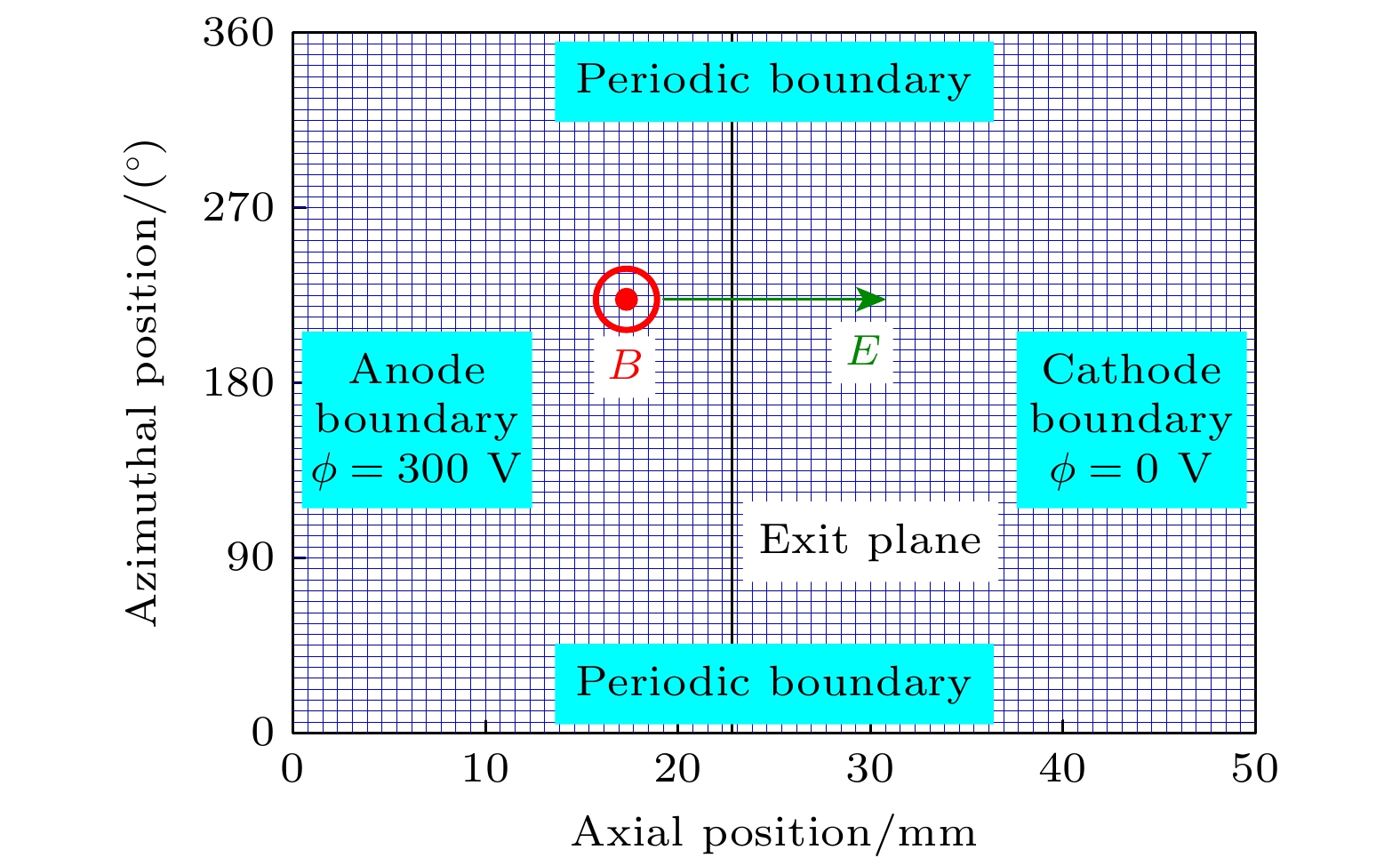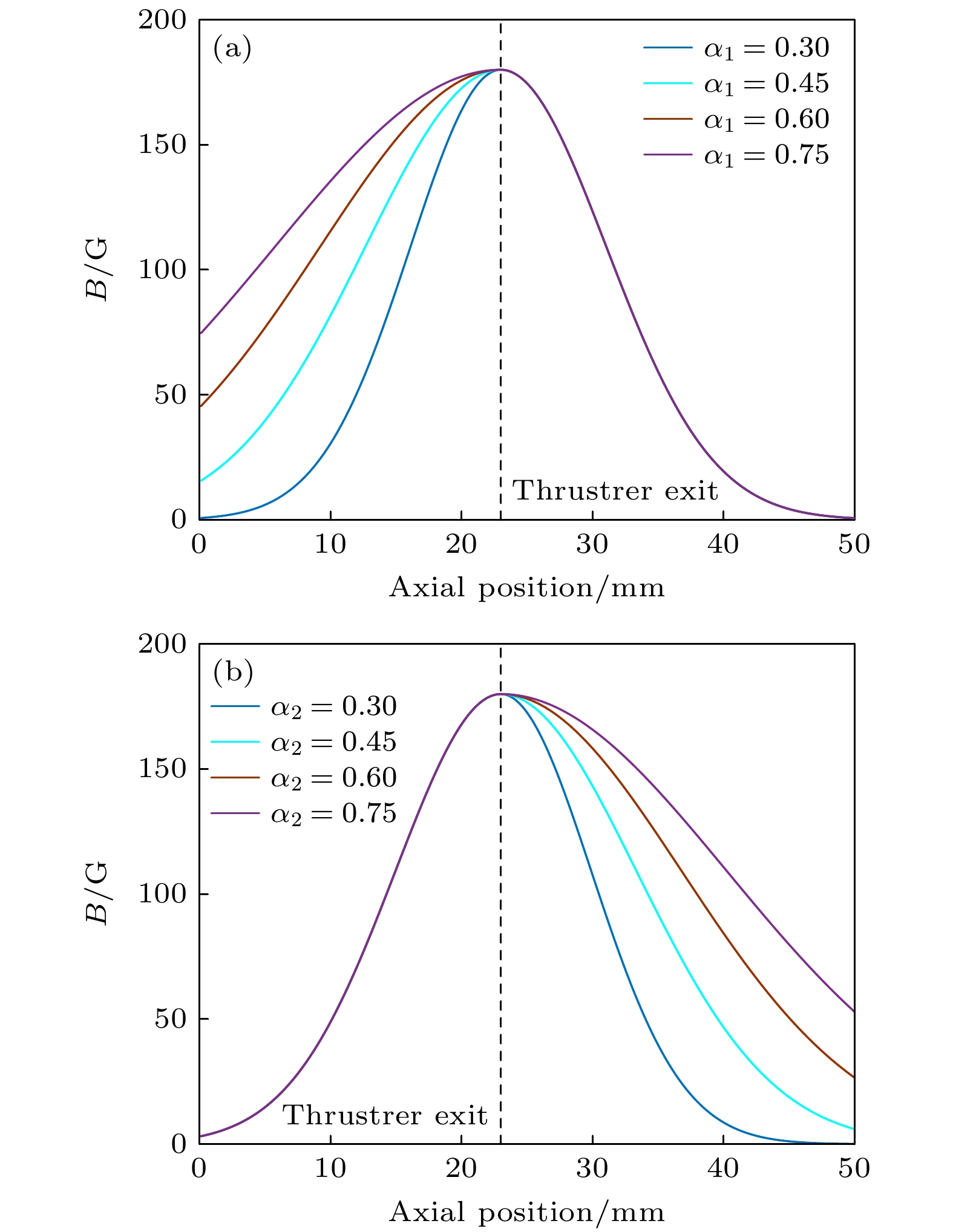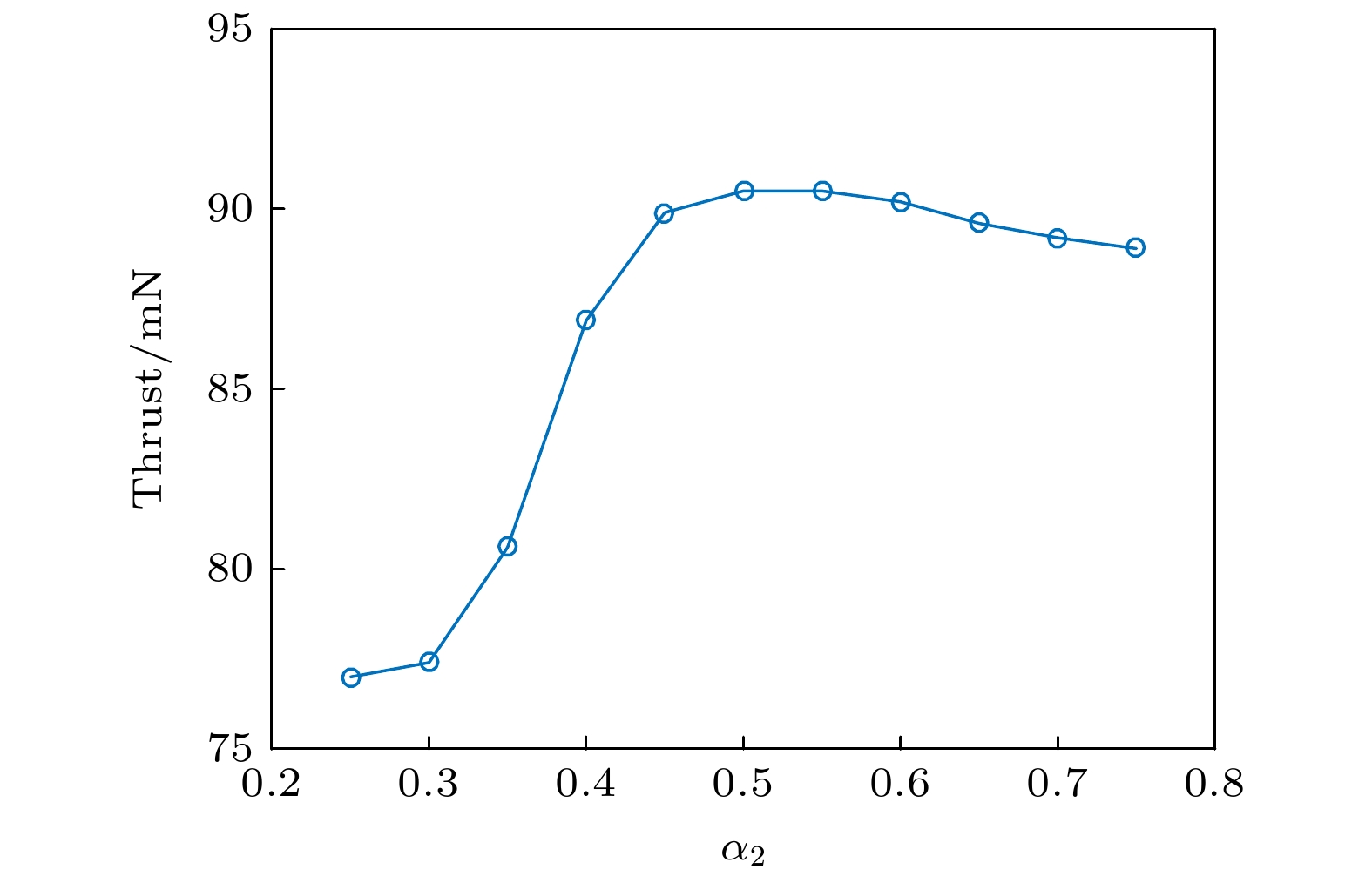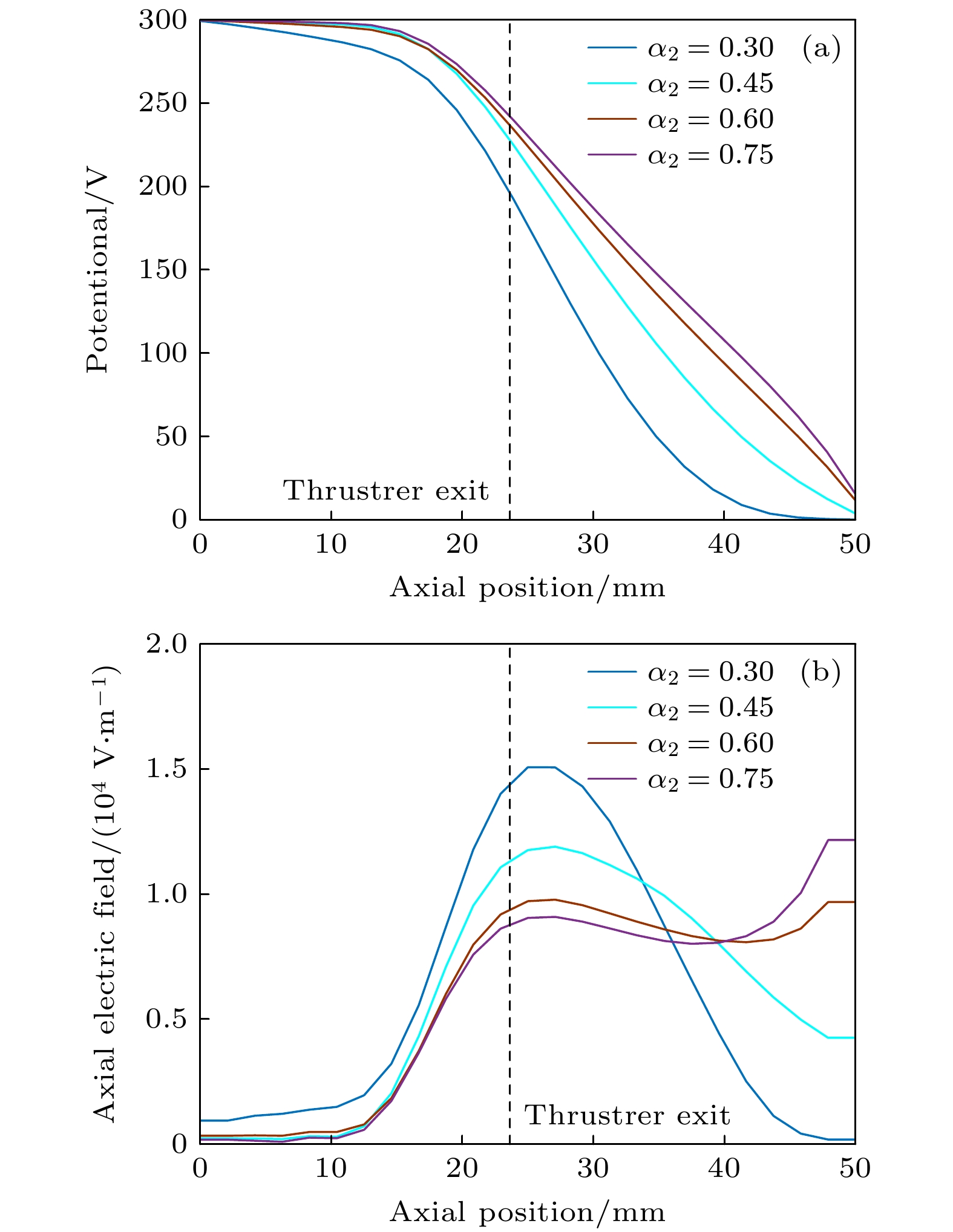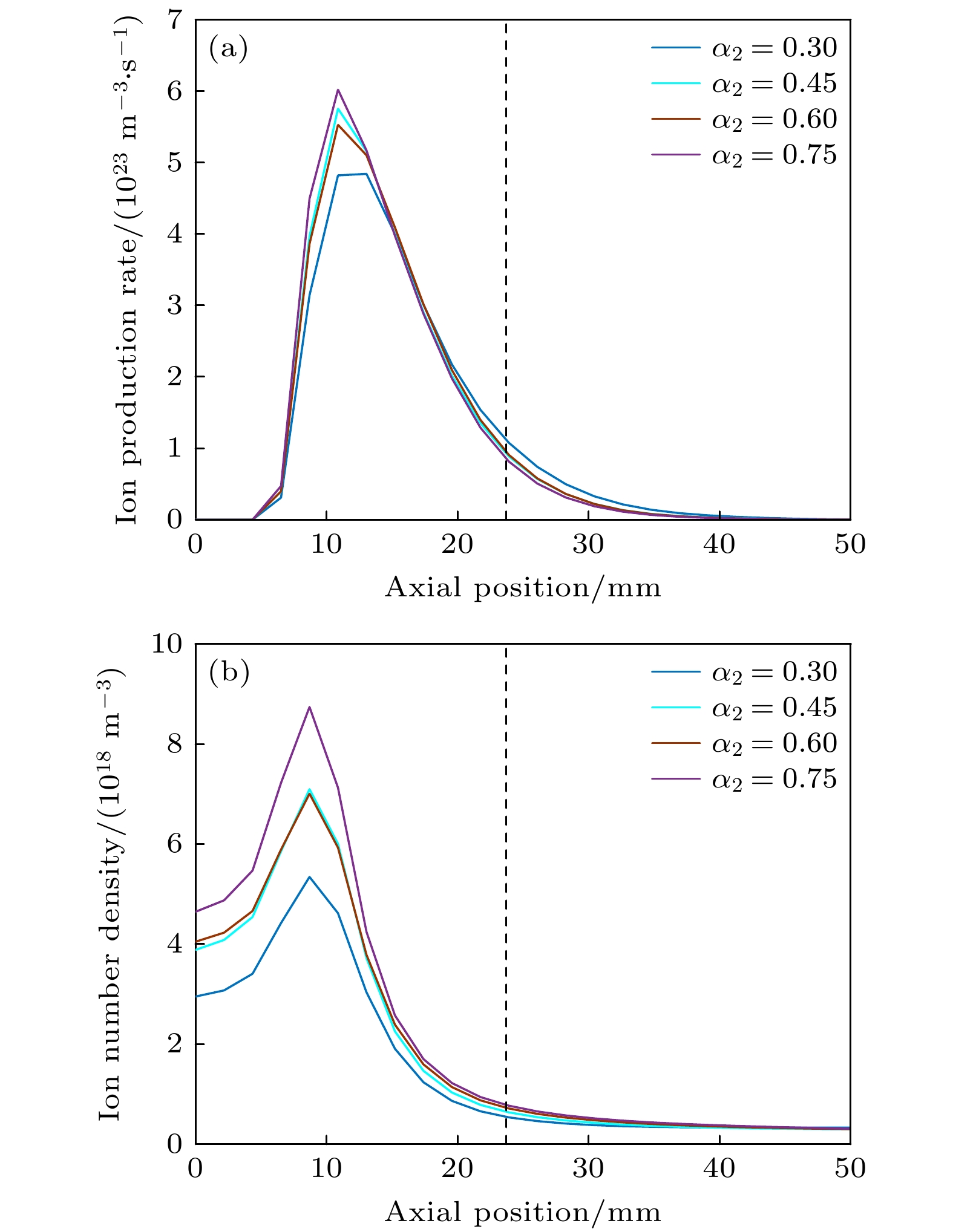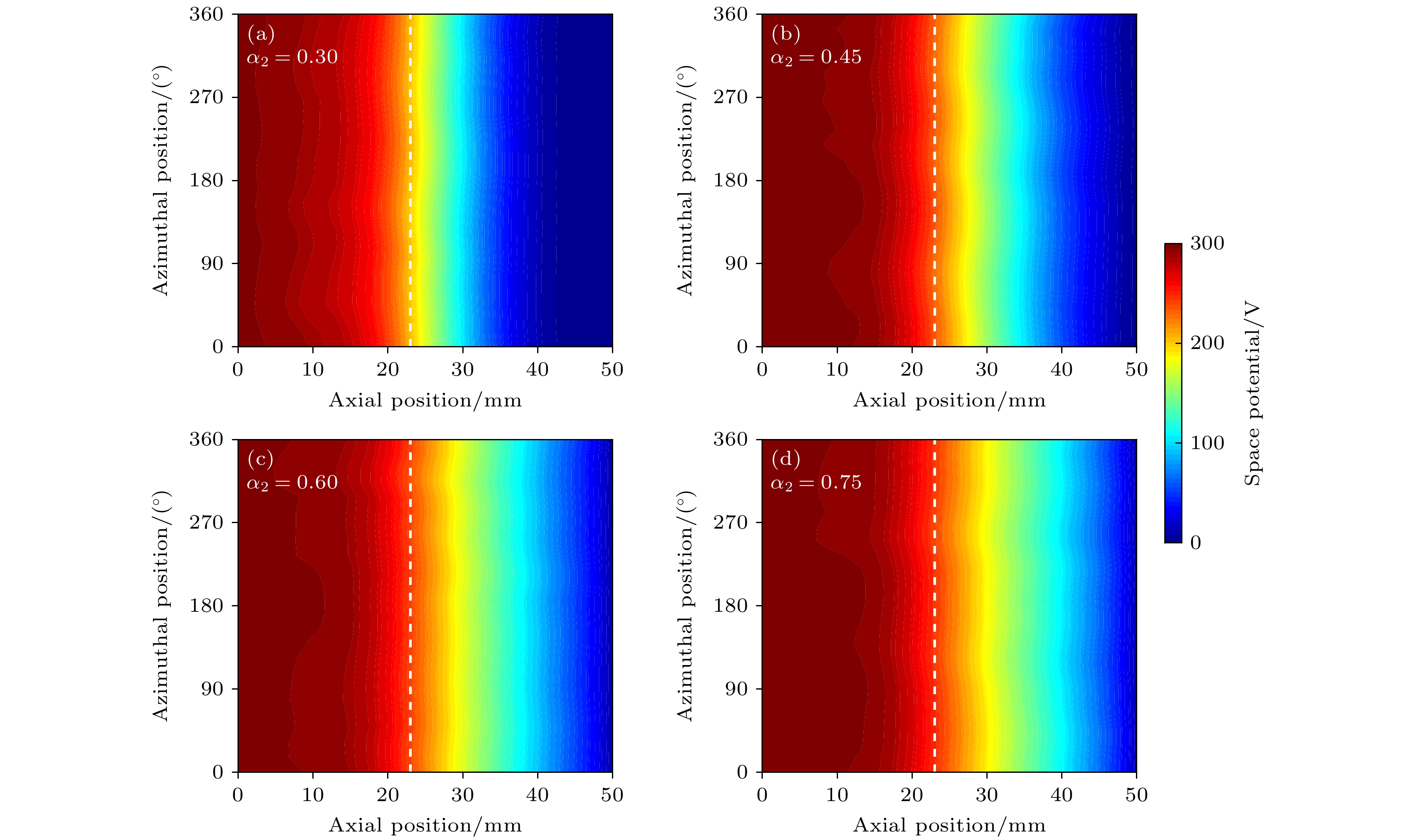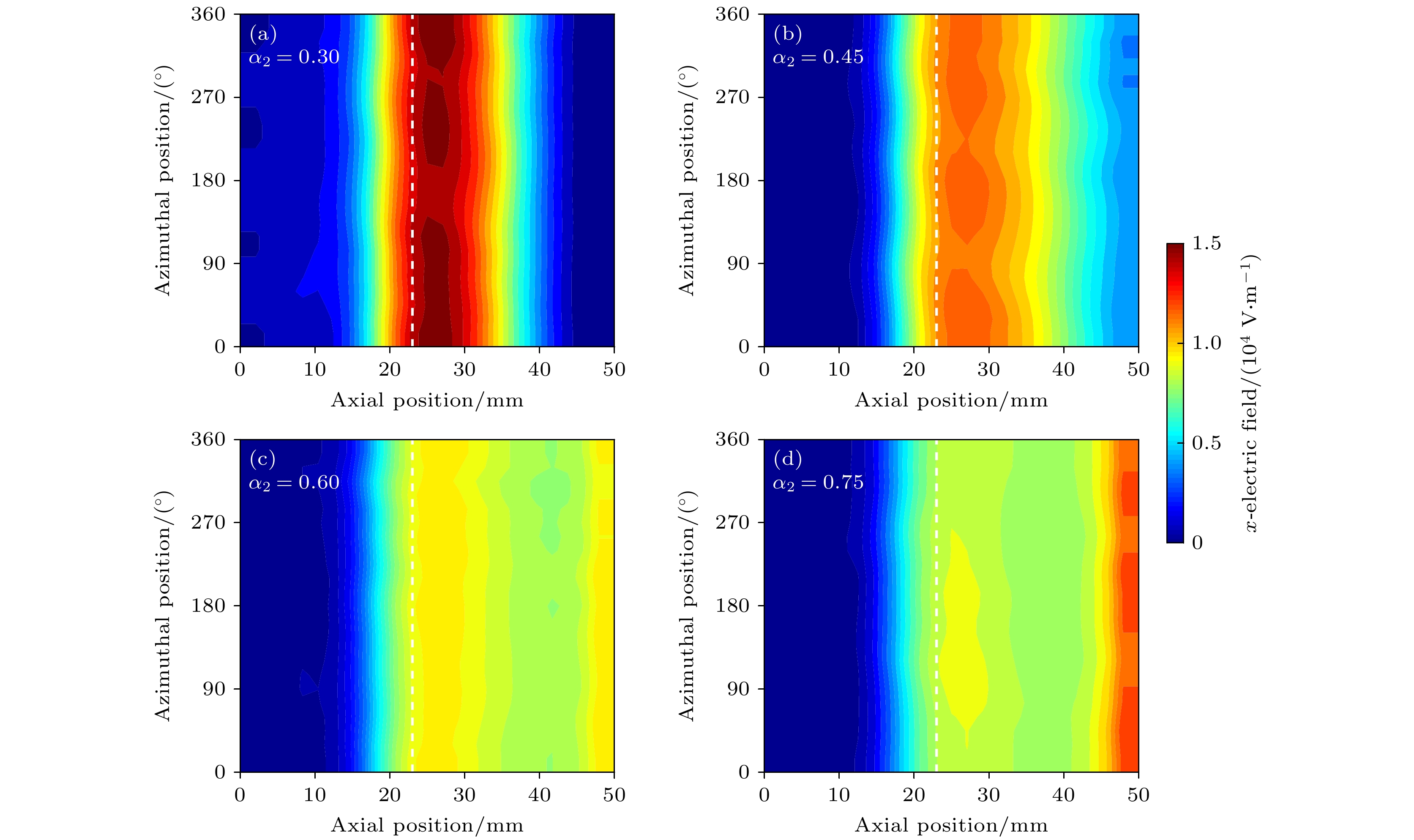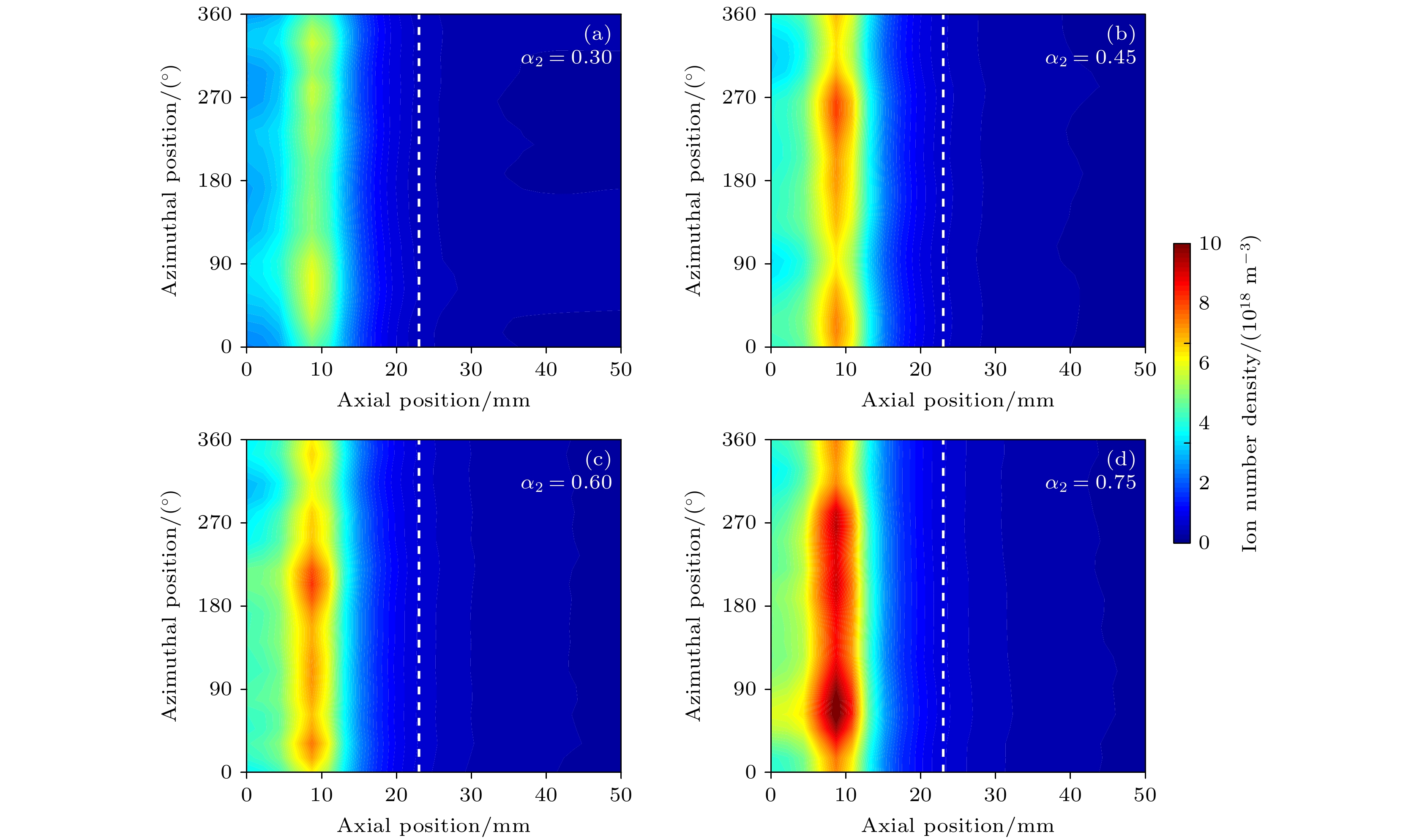-
磁场作为霍尔推力器的关键设计参数之一, 其通过直接影响电子输运、中性原子电离、等离子体分布等微观行为, 间接影响推力器的宏观性能. 目前, 针对霍尔推力器磁场影响的研究更多的是关注放电通道内磁场大小以及分布的影响, 而对羽流区磁场的影响研究相对较少. 基于此, 本文利用二维粒子-流体混合模型研究了霍尔推力器羽流区的轴向磁场分布对推力器性能的影响. 结果表明, 在放电通道内轴向磁场分布不变的情况下, 改变羽流区的轴向磁场梯度对推力具有显著的影响. 放电通道中的电势降随着羽流区轴向磁场梯度的减小而减小, 羽流区电场以及放电通道中的离子数密度峰值则随着羽流区轴向磁场梯度的减小而增加. 增加羽流区的磁感应强度, 有助于推力器性能的提升. 更明确地说, 羽流区的磁场梯度存在一个临界值, 当羽流区轴向磁场梯度大于临界值时, 推力随羽流区轴向磁场梯度的减小而增加. 当羽流区轴向磁场梯度小于临界值时, 推力随羽流区轴向磁场梯度的减小而轻微的减小. 通过对不同羽流区磁场分布下的等离子体电势、电场、离子数密度, 以及电离率分布的比较表明, 羽流区磁场通过影响电子迁移率改变电场的分布, 而电场分布的改变则会对推力产生影响. 本文的研究结果将对霍尔推力器性能优化, 以及磁场设计提供理论支撑.As one of the key design parameters of Hall thruster, magnetic field indirectly influences the macroscopic performance of the thruster by directly affecting electron transport, neutral atom ionization, plasma distribution and other microscopic behaviors. At present, the research on the influence of Hall thruster’s magnetic field focuses mostly on the size and distribution of the magnetic field in the discharge channel, but less on the influence of the plume magnetic field on the thruster. Based on this, the effect of plume region axial magnetic field profile on the performance of Hall thruster is studied by using two-dimensional hybrid simulation. The research results show that the axial magnetic field gradient in the plume region has a significant influence on the thruster performance, when the magnetic field characteristics (magnetic field topology and magnetic field intensity) in the discharge channel remain unchanged. The potential drop in the discharge channel decreases with the axial magnetic field gradient in the plume region decreasing. However, the electric field in the plume region and the peak ion number density in the discharge channel increase with the axial magnetic field gradient in the plume region decreasing. Overall, the performance of the thruster is improved by increasing the magnetic field strength in the plume region. More specifically, there is a critical value of axial magnetic field gradient in the plume region. When the axial magnetic field gradient in the plume region is greater than the critical value, the thrust increases with the axial magnetic field gradient decreasing. When the axial magnetic field gradient of the plume region is less than the critical value, the thrust decreases slightly with the axial magnetic field gradient decreasing. The comparison of plasma potential, electric field, ion number density, and ionization rate distribution under different magnetic field distributions in the plume region shows that the effect of plume magnetic field on thrust is to affect the spatial electric field distribution by affecting the mobility of electrons, thus causing the thrust to change due to electric field. The research results of this paper will provide theoretical support for improving the performance of hall thrusters and designing magnetic fields.
-
Keywords:
- Hall thruster /
- plume region /
- gradient of magnetic field /
- ionization rate
[1] Mazouffre S 2016 Plasma Sources Sci. Technol. 25 033002
 Google Scholar
Google Scholar
[2] Li W B, Ding Y J, Wei L Q, Han L, Yu D R 2017 Vacuum 136 77
 Google Scholar
Google Scholar
[3] Taccogna F, Minelli P, Capitelli M, Longo S 2012 Am. Instit. Phys. 1501 1390
 Google Scholar
Google Scholar
[4] Raitses Y, Fisch N J 2001 Phys. Plasmas 8 2579
 Google Scholar
Google Scholar
[5] Shitrit S, Ashkenazy J, Appelbaum G, Warshavsky A 2008 IEEE Trans. Plasma Sci. 36 2025
 Google Scholar
Google Scholar
[6] Gawron D, Mazouffre S, Sadeghi N, Héron A 2008 Plasma Sources Sci. Technol. 17 025001
 Google Scholar
Google Scholar
[7] Shmelev A V, Lovtsov A S 2012 Tech. Phys. Lett. 38 544
 Google Scholar
Google Scholar
[8] Hofer R R, Geoibel D M, Mikellides I G, Katz I, 2014 J. Appl. Phys. 115 043304
 Google Scholar
Google Scholar
[9] Li H, Fan H T, Liu X Y, Ding M H, Ding Y J, Wei L Q, Yu D R, Wang X G 2019 Vacuum 162 78
 Google Scholar
Google Scholar
[10] Garrigues L, Hagelarr G J M, Bareilles J, Boniface C, Boeuf J P 2003 Phys. Plasmas 10 4886
 Google Scholar
Google Scholar
[11] Sommier E, Allis M K, Cappelli M A 2005 The 29th International Electric Propulsion Conference Princeton NJ, USA, October 31–November 4, 2005 IEPC-2005-189
[12] Ahedo E, Antón A, Garmendia I, Caro I 2007 The 30th International Electric Propulsion Conference Florence, Italy, September 17–20, 2007 IEPC-2007-067
[13] Boniface C, Garrigues L, Hagelaar G J M, Boefu J P 2006 Appl. Phys. Lett. 89 161503
 Google Scholar
Google Scholar
[14] Hara K, Sekerak M J, Boyd I D, Gallimore A D 2014 J. Appl. Phys. 115 203304
 Google Scholar
Google Scholar
[15] Perales-Dĺaz J, Domĺnguez-Vázquez Fajardo P, Ahedo E, Faraji F, Reza M, Andreussi T 2022 J. Appl. Phys. 131 103302
 Google Scholar
Google Scholar
[16] Jiang Y W, Tang H B, Ren J X, Li M, Cao J B 2018 J. Phys. D: Appl. Phys. 51 1627
 Google Scholar
Google Scholar
[17] Liu J W, Li H, Hu Y L, Liu X Y, Ding Y J, Wei L Q, Yu D R, Wang X G 2019 Contrib. Plasma Phys. 59 e201800001
 Google Scholar
Google Scholar
[18] 杨三祥, 王倩楠, 高俊, 贾艳辉, 耿海, 郭宁, 陈新伟, 袁兴龙, 张鹏 2022 物理学报 71 105201
 Google Scholar
Google Scholar
Yang S X, Wang Q N, Gao J, Jia Y H, Geng H, Guo N, Chen X W, Yuan X L, Zhang P 2022 Acta Phys. Sin. 71 105201
 Google Scholar
Google Scholar
[19] Keidar M, Boyd I D 1999 J. Appl. Phys. 86 4786
 Google Scholar
Google Scholar
[20] Mikellides I G, Katz I, Mandell M J, Snyder J S 2001 37th AIAA/ASME/SAE/AHS/ASEE Joint Propulsion Conference & Exhibit Salt Lake City, Utah, July 8–11, 2001 AIAA-2001-3505
[21] Boyd I D, Yim J M 2004 J. Appl. Phys. 95 4575
 Google Scholar
Google Scholar
[22] Raitses Y, Gaysoso J C, Merino E, Fisch N J 2010 46th AIAA/ASME/SAE/AHS/ASEE Joint Propulsion Conference & Exhibit Nashville, TN, July 25–28, 2010 AIAA-2010-6621
[23] Hu P, Liu H, Mao W, Yu D R, Gao Y Y 2015 Phys. Plasmas 22 103502
 Google Scholar
Google Scholar
[24] Kim H, Lim Y, Choe W, Park S, Seon J 2015 Appl. Phys. Lett. 106 154103
 Google Scholar
Google Scholar
[25] Singh S, Malik H K 2023 J. Astrophys. Astr. 44 3
 Google Scholar
Google Scholar
[26] Hofer R R, Gallimore A D 2006 J. Propul. Power 22 721
 Google Scholar
Google Scholar
[27] Hofer R R, Gallimore A D 2006 J. Propul. Power 22 732
 Google Scholar
Google Scholar
[28] Henaux C, Vilamot R, Garrigues L, Harribey D 2012 20th International Conferences on Electrical Machines Marseille, France, September 2–5, 2012 p2533
[29] Domonkos M T, Gallimore A D, Marrese C M, Haas J M 2000 J. Propul. Power 16 91
 Google Scholar
Google Scholar
[30] Liang R, Gallimore A D 2011 49th AIAA Aerospace Sciences Meeting Kissimmee, Florida, January 4–7, 2011 AIAA-2011-1016
[31] Adam J C, Héron A, Laval G 2004 Phys. Plasma 11 295
 Google Scholar
Google Scholar
[32] Lafleur T, Martorelli R, Chabert P, Bourdon A 2018 Phys. Plasma 25 061202
 Google Scholar
Google Scholar
[33] Coche P, Garrigues L 2014 Phys. Plasmas 21 023503
 Google Scholar
Google Scholar
[34] Chen L, Kan Z C, Gao W F, Duan P, Chen J Y, Tan C Q, Cui Z J 2024 Chin. Phys. B 33 015203
 Google Scholar
Google Scholar
[35] Yu D R, Qing S W, Liu H, Li H 2011 Contrib. Plasma Phys. 51 955
 Google Scholar
Google Scholar
[36] Yu D R, Song M, Liu H, Ding Y J, Li H 2012 Phys. Plasmas 19 033503
 Google Scholar
Google Scholar
[37] Szabo J, Warner N, Martinez-Sanchez M, Batishchev O 2014 J. Propuls. Power 30 197
 Google Scholar
Google Scholar
[38] Taccogna F, Minelli P 2018 Phys. Plasmas 25 061208
 Google Scholar
Google Scholar
[39] Garrigues L, Hagelarr G J M, Boniface C, Boeuf J P 2004 Appl. Phys. Lett. 85 5460
 Google Scholar
Google Scholar
[40] Kawashima R, Hara K, Komurasaki K 2018 Plasma Sources Sci. Technol. 27 035010
 Google Scholar
Google Scholar
[41] Katz I, Jongeward G, Davis V, et al. 2001 37th AIAA/ASME/SAE/AHS/ASEE Joint Propulsion Conference & Exhibit Salt Lake City, Utah, July 8–11, 2001 AIAA-2001-3355
[42] Kawashima R, Komurasaki K, Schönherr T Koizumi H 2016 54th AIAA Aerospace Sciences Meeting San Diego, California, USA, January 4–8, 2016 AIAA-2016-2159
[43] Kawashima R, Wang Z X, Chamarthi A S 2018 55th AIAA Aerospace Sciences Meeting Kissimmee, Florida, January 8–12, 2018 AIAA-2018-0175
[44] Hofer R R, Mikellides I G, Katz I, Goebel D M 2007 43rd AIAA/ASME/ASCE/AHS/ASC Structures, Structural Dynamics, and Materials Conference Honolulu, Hawaii, April 23–26, 2007 AIAA-2007-5267
[45] Manzella D, Jankovsky R, Elliott F, Mikellides I, Jongeward G, Allen D 2001 27th International Electric Propulsion Conference Pasadena, CA, October 15–19, 2001 IEPC-2001-044
[46] Andreussi T, Giannetti V, Leporini A, Saravia M M, Andrenucci M 2017 Plasma Phys. Control. Fusion. 60 014015
 Google Scholar
Google Scholar
[47] Fujita D, Kawashima R, Ito Y, Akagi S, Suzuki J, Schonherr T, Koizumi H, Komurasaki K 2014 Vacuum 10 159
 Google Scholar
Google Scholar
-
-
[1] Mazouffre S 2016 Plasma Sources Sci. Technol. 25 033002
 Google Scholar
Google Scholar
[2] Li W B, Ding Y J, Wei L Q, Han L, Yu D R 2017 Vacuum 136 77
 Google Scholar
Google Scholar
[3] Taccogna F, Minelli P, Capitelli M, Longo S 2012 Am. Instit. Phys. 1501 1390
 Google Scholar
Google Scholar
[4] Raitses Y, Fisch N J 2001 Phys. Plasmas 8 2579
 Google Scholar
Google Scholar
[5] Shitrit S, Ashkenazy J, Appelbaum G, Warshavsky A 2008 IEEE Trans. Plasma Sci. 36 2025
 Google Scholar
Google Scholar
[6] Gawron D, Mazouffre S, Sadeghi N, Héron A 2008 Plasma Sources Sci. Technol. 17 025001
 Google Scholar
Google Scholar
[7] Shmelev A V, Lovtsov A S 2012 Tech. Phys. Lett. 38 544
 Google Scholar
Google Scholar
[8] Hofer R R, Geoibel D M, Mikellides I G, Katz I, 2014 J. Appl. Phys. 115 043304
 Google Scholar
Google Scholar
[9] Li H, Fan H T, Liu X Y, Ding M H, Ding Y J, Wei L Q, Yu D R, Wang X G 2019 Vacuum 162 78
 Google Scholar
Google Scholar
[10] Garrigues L, Hagelarr G J M, Bareilles J, Boniface C, Boeuf J P 2003 Phys. Plasmas 10 4886
 Google Scholar
Google Scholar
[11] Sommier E, Allis M K, Cappelli M A 2005 The 29th International Electric Propulsion Conference Princeton NJ, USA, October 31–November 4, 2005 IEPC-2005-189
[12] Ahedo E, Antón A, Garmendia I, Caro I 2007 The 30th International Electric Propulsion Conference Florence, Italy, September 17–20, 2007 IEPC-2007-067
[13] Boniface C, Garrigues L, Hagelaar G J M, Boefu J P 2006 Appl. Phys. Lett. 89 161503
 Google Scholar
Google Scholar
[14] Hara K, Sekerak M J, Boyd I D, Gallimore A D 2014 J. Appl. Phys. 115 203304
 Google Scholar
Google Scholar
[15] Perales-Dĺaz J, Domĺnguez-Vázquez Fajardo P, Ahedo E, Faraji F, Reza M, Andreussi T 2022 J. Appl. Phys. 131 103302
 Google Scholar
Google Scholar
[16] Jiang Y W, Tang H B, Ren J X, Li M, Cao J B 2018 J. Phys. D: Appl. Phys. 51 1627
 Google Scholar
Google Scholar
[17] Liu J W, Li H, Hu Y L, Liu X Y, Ding Y J, Wei L Q, Yu D R, Wang X G 2019 Contrib. Plasma Phys. 59 e201800001
 Google Scholar
Google Scholar
[18] 杨三祥, 王倩楠, 高俊, 贾艳辉, 耿海, 郭宁, 陈新伟, 袁兴龙, 张鹏 2022 物理学报 71 105201
 Google Scholar
Google Scholar
Yang S X, Wang Q N, Gao J, Jia Y H, Geng H, Guo N, Chen X W, Yuan X L, Zhang P 2022 Acta Phys. Sin. 71 105201
 Google Scholar
Google Scholar
[19] Keidar M, Boyd I D 1999 J. Appl. Phys. 86 4786
 Google Scholar
Google Scholar
[20] Mikellides I G, Katz I, Mandell M J, Snyder J S 2001 37th AIAA/ASME/SAE/AHS/ASEE Joint Propulsion Conference & Exhibit Salt Lake City, Utah, July 8–11, 2001 AIAA-2001-3505
[21] Boyd I D, Yim J M 2004 J. Appl. Phys. 95 4575
 Google Scholar
Google Scholar
[22] Raitses Y, Gaysoso J C, Merino E, Fisch N J 2010 46th AIAA/ASME/SAE/AHS/ASEE Joint Propulsion Conference & Exhibit Nashville, TN, July 25–28, 2010 AIAA-2010-6621
[23] Hu P, Liu H, Mao W, Yu D R, Gao Y Y 2015 Phys. Plasmas 22 103502
 Google Scholar
Google Scholar
[24] Kim H, Lim Y, Choe W, Park S, Seon J 2015 Appl. Phys. Lett. 106 154103
 Google Scholar
Google Scholar
[25] Singh S, Malik H K 2023 J. Astrophys. Astr. 44 3
 Google Scholar
Google Scholar
[26] Hofer R R, Gallimore A D 2006 J. Propul. Power 22 721
 Google Scholar
Google Scholar
[27] Hofer R R, Gallimore A D 2006 J. Propul. Power 22 732
 Google Scholar
Google Scholar
[28] Henaux C, Vilamot R, Garrigues L, Harribey D 2012 20th International Conferences on Electrical Machines Marseille, France, September 2–5, 2012 p2533
[29] Domonkos M T, Gallimore A D, Marrese C M, Haas J M 2000 J. Propul. Power 16 91
 Google Scholar
Google Scholar
[30] Liang R, Gallimore A D 2011 49th AIAA Aerospace Sciences Meeting Kissimmee, Florida, January 4–7, 2011 AIAA-2011-1016
[31] Adam J C, Héron A, Laval G 2004 Phys. Plasma 11 295
 Google Scholar
Google Scholar
[32] Lafleur T, Martorelli R, Chabert P, Bourdon A 2018 Phys. Plasma 25 061202
 Google Scholar
Google Scholar
[33] Coche P, Garrigues L 2014 Phys. Plasmas 21 023503
 Google Scholar
Google Scholar
[34] Chen L, Kan Z C, Gao W F, Duan P, Chen J Y, Tan C Q, Cui Z J 2024 Chin. Phys. B 33 015203
 Google Scholar
Google Scholar
[35] Yu D R, Qing S W, Liu H, Li H 2011 Contrib. Plasma Phys. 51 955
 Google Scholar
Google Scholar
[36] Yu D R, Song M, Liu H, Ding Y J, Li H 2012 Phys. Plasmas 19 033503
 Google Scholar
Google Scholar
[37] Szabo J, Warner N, Martinez-Sanchez M, Batishchev O 2014 J. Propuls. Power 30 197
 Google Scholar
Google Scholar
[38] Taccogna F, Minelli P 2018 Phys. Plasmas 25 061208
 Google Scholar
Google Scholar
[39] Garrigues L, Hagelarr G J M, Boniface C, Boeuf J P 2004 Appl. Phys. Lett. 85 5460
 Google Scholar
Google Scholar
[40] Kawashima R, Hara K, Komurasaki K 2018 Plasma Sources Sci. Technol. 27 035010
 Google Scholar
Google Scholar
[41] Katz I, Jongeward G, Davis V, et al. 2001 37th AIAA/ASME/SAE/AHS/ASEE Joint Propulsion Conference & Exhibit Salt Lake City, Utah, July 8–11, 2001 AIAA-2001-3355
[42] Kawashima R, Komurasaki K, Schönherr T Koizumi H 2016 54th AIAA Aerospace Sciences Meeting San Diego, California, USA, January 4–8, 2016 AIAA-2016-2159
[43] Kawashima R, Wang Z X, Chamarthi A S 2018 55th AIAA Aerospace Sciences Meeting Kissimmee, Florida, January 8–12, 2018 AIAA-2018-0175
[44] Hofer R R, Mikellides I G, Katz I, Goebel D M 2007 43rd AIAA/ASME/ASCE/AHS/ASC Structures, Structural Dynamics, and Materials Conference Honolulu, Hawaii, April 23–26, 2007 AIAA-2007-5267
[45] Manzella D, Jankovsky R, Elliott F, Mikellides I, Jongeward G, Allen D 2001 27th International Electric Propulsion Conference Pasadena, CA, October 15–19, 2001 IEPC-2001-044
[46] Andreussi T, Giannetti V, Leporini A, Saravia M M, Andrenucci M 2017 Plasma Phys. Control. Fusion. 60 014015
 Google Scholar
Google Scholar
[47] Fujita D, Kawashima R, Ito Y, Akagi S, Suzuki J, Schonherr T, Koizumi H, Komurasaki K 2014 Vacuum 10 159
 Google Scholar
Google Scholar
计量
- 文章访问数: 3471
- PDF下载量: 112
- 被引次数: 0













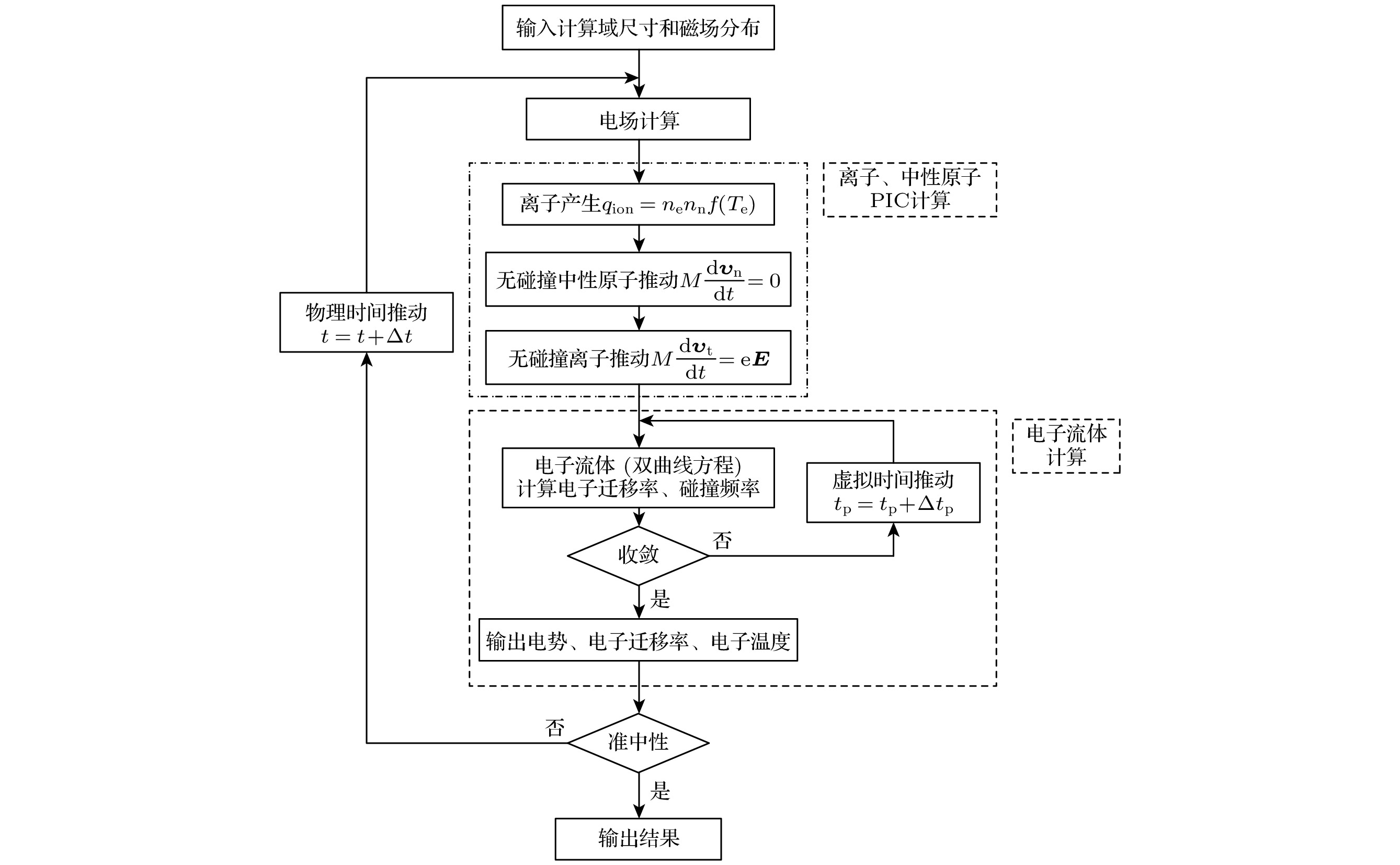
 下载:
下载:
